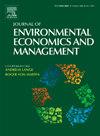林冠之外:卫星数据检测阈值如何影响政策评估和森林砍伐行为
IF 5.9
3区 经济学
Q1 BUSINESS
Journal of Environmental Economics and Management
Pub Date : 2025-08-14
DOI:10.1016/j.jeem.2025.103219
引用次数: 0
摘要
卫星数据对于执行和评估环境政策至关重要,但是监测系统的技术限制可能产生不正当的激励和偏见影响评估。本研究探讨卫星监测系统的探测阈值如何影响森林保护政策的执行和评价。我们确定了三个关键机制:测量问题,其中具有较大最小检测阈值的数据集系统地错过了小规模森林砍伐;漏洞效应,政策只会减少可察觉的大规模森林砍伐;战略适应,即受监管的主体调整行为以利用已知的检测阈值,从大规模森林砍伐到小规模森林砍伐。研究巴西2008年的市政黑名单政策,我们发现,政府的主要监测系统不报告6.25公顷以下的补丁,与最低检测阈值较小的数据集相比,高估了政策有效性三分之一。当用这些数据集进行测量时,黑名单使森林砍伐比基线减少了31.2%——大大低于政府数据所显示的47.6%。平均砍伐面积下降了28.9%,低于检测阈值的斑块显著增加,反映了未被检测到的和战略上分散的活动。我们的分析揭示了环境治理面临的一个关键挑战:随着监测系统的改进,逃避策略也在改进,这需要密切关注技术如何影响观察到的结果和实地激励措施。本文章由计算机程序翻译,如有差异,请以英文原文为准。
Beyond the canopy: How satellite data detection thresholds influence policy evaluation and deforestation behavior
Satellite data is essential for enforcing and evaluating environmental policy, but technological limitations of monitoring systems can create perverse incentives and bias impact assessment. This study examines how detection thresholds in satellite monitoring systems affect both the implementation and evaluation of forest conservation policies. We identify three key mechanisms: a measurement issue, where datasets with larger minimum detection thresholds systematically miss small-scale deforestation; a loophole effect, where policy only reduces detectable, large-scale deforestation; and strategic adaptation, where regulated agents adjust behavior to exploit known detection thresholds, substituting from large- to small-scale deforestation. Studying Brazil’s 2008 municipal Blacklisting policy, we find that the government’s primary monitoring system, which does not report patches below 6.25 hectares, overestimates policy effectiveness by a third compared to datasets with smaller minimum detection thresholds. When measured with those datasets, blacklisting reduced deforestation by 31.2 % from baseline—substantially less than the 47.6 % reduction suggested by government data. Average clearing size declined by 28.9 %, with significant increases in patches below detection thresholds, reflecting both undetected and strategically fragmented activity. Our analysis reveals a critical challenge for environmental governance: as monitoring systems improve, so too do evasion strategies, requiring close attention to how technology shapes observed outcomes and on-the-ground incentives.
求助全文
通过发布文献求助,成功后即可免费获取论文全文。
去求助
来源期刊
CiteScore
8.00
自引率
4.30%
发文量
91
期刊介绍:
The Journal of Environmental Economics and Management publishes theoretical and empirical papers devoted to specific natural resources and environmental issues. For consideration, papers should (1) contain a substantial element embodying the linkage between economic systems and environmental and natural resources systems or (2) be of substantial importance in understanding the management and/or social control of the economy in its relations with the natural environment. Although the general orientation of the journal is toward economics, interdisciplinary papers by researchers in other fields of interest to resource and environmental economists will be welcomed.

 求助内容:
求助内容: 应助结果提醒方式:
应助结果提醒方式:


